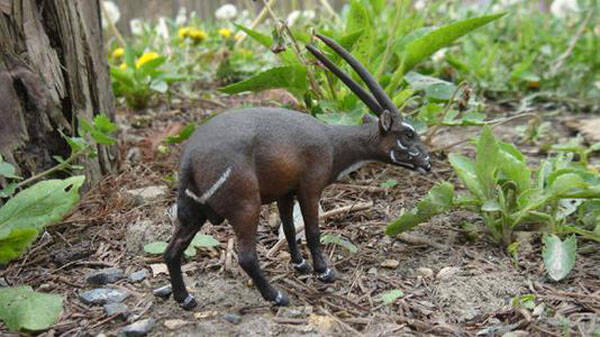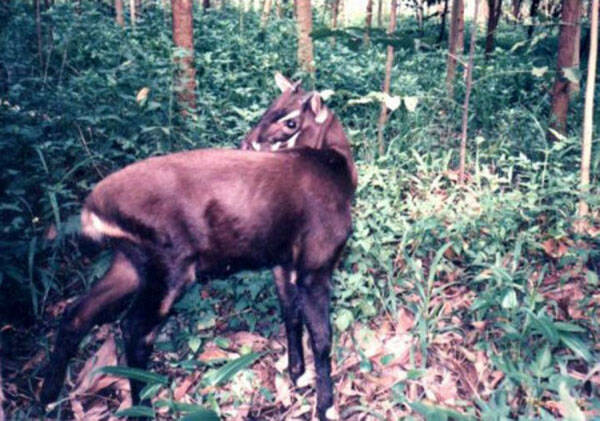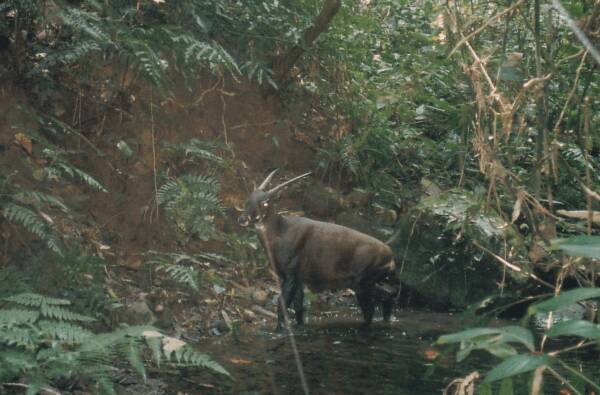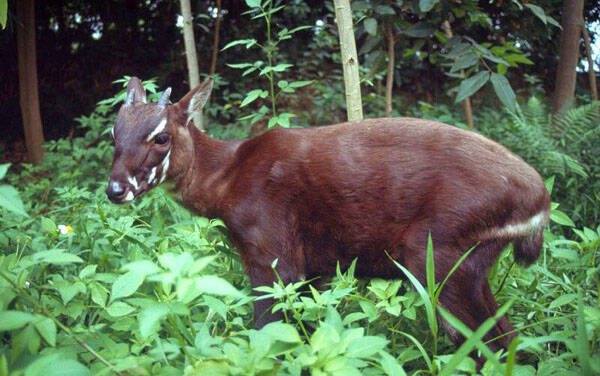Pseudoryx nghetinhensis
IUCN
LCBasic Information
Scientific classification
- name:Pseudoryx nghetinhensis
- Scientific Name:Pseudoryx nghetinhensis,Annamite antelope, Asian unicorn, Asian unicorn, Wuguang cattle, sword-horned cattle, Saura antelope
- Outline:Ungulata
- Family:Artiodactyla Bovidae Saotarga
Vital signs
- length:About 150 cm
- Weight:About 100kg
- lifetime:8+ years
Feature
It looks like an antelope, but when viewed from the side it appears to have only one horn, so it is also called the "Asian Unicorn".
Distribution and Habitat
The saola is found in the forests of the Annamites along the border between Vietnam and Laos. The most scientifically documented observations are south of the Red River in Vietnam, although small populations have been found north of the river.
In Laos, the saola is found in Bolikhamxay, Khammouane, Savannakhet, Xekong, and possibly south of Xieng Khouang.
In Vietnam, it is found in Nghe An, Ha Tinh, Quang Binh, Quang Tri, Thua Thien Hue, and Quang Nam.
The total area of the saola distribution is about 4,000 square kilometers, and the historical distribution range may have reached 15,000 square kilometers.
The saola inhabits the forests of the Annamites, where precipitation is received almost every month and there is no distinct dry season. Most of the recorded habitats are moist evergreen broad-leaved forests at mid-elevation, mostly hairy-leaved sedge forests of the Dipterocarpaceae family, generally at altitudes of 400-800m, sometimes at around 200m. The forest area of
Appearance
There are few measurements of living saola. It weighs about 100kg, is about 150cm long, and is 80-90cm tall at the shoulder. There is no significant difference between males and females (1995).
The color of the saola is generally dark brown, but individuals vary from reddish brown to nearly black. The hair on the upper body is short, fine, and shiny, and the hair on the head and neck is even shorter. The hair of the saola is particularly soft and fine, probably due to the cool and humid weather in some areas of its distribution. The hair on the abdomen is brown, darker than the upper body, and covered with fluffy hairs about 3.5cm long. The skin around the buttocks and in the crotch (including the scrotum skin of males) is white. The dark fur of the lower body extends from the neck and shoulders, and looks like a conspicuous patch from the side. A thin black stripe 0.5cm wide runs along the spine from the shoulders to the tip of the tail, fading out at the end. A white stripe runs a
Details
The Saola (scientific name: Pseudoryx nghetinhensis), also known as Wu Guang Niu and Asian Qilin, is a monotypic species of the genus Saola in the family Bovidae of the order Artiodactylus. The Saola is a large mammal discovered in 1992. Its unique appearance caused a sensation in the scientific community and attracted interest in its research. Because of its uniqueness, it is so different from known animals that a genus was specially assigned to it. Attempts have been made to classify it into the families and genera of known ungulates, but its characteristics make it impossible to describe it with known genera. For example, it was once classified into three branches of the subfamily Bovinae (the blue antelope tribe, the cattle tribe, and the bushbuck tribe) based on morphological characteristics, and it was also classified into the subfamily Caprinae (especially the most similar antelope tribe, which includes the serow and Himalayan goral). In 1999, Hassanin and Douzery's genetic analysis (based on analysis of mitochondrial DNA and RNA genes) showed that the saola is closest to the Bovinae subfamily, and they believed that the saola should be classified in the Bovinae tribe. The current consensus is to classify it into a separate genus, Saola (2005).

Based on reports from local residents, scholars believe that the saola is a solitary animal. Adult saolas are basically like this, but most female saolas live with their cubs. The reports provided by the original discoverers described that saolas would form small groups of 2-3 when migrating, but rarely groups of six or seven.
Most of the information about the habits of the saola comes from the female saola captured in 1998. The saola is diurnal, mainly active during the day and dawn, although there may be some deviations from human activity times. They often put their heads on the ground and close their eyes to rest at night, and they tuck their feet under their bodies when they sleep. In the morning, they basically chew food. According to local Lao people, they are most active in the morning, late afternoon and evening, and are not so active when the sun is overhead, although a camera once captured a saola active at 11:50 noon in 1999.
When facing humans, the saola appears relatively gentle, but when facing dogs, they will have a strong defensive reaction: they will face the enemy head-on, put their feet in place, arch their backs, bend their heads, point their pointed horns at the dogs, and at the same time, the glands in their upper jaws bulge outwards, accompanied by snorting from their noses. If they are chased by dogs in the wild, they will run to the nearest stream, leaving the dogs standing stupidly by the stream.

Licking the tongue is an important part of the daily life of the saola, mainly used to drive away flies that gather. The eyes and face are the most licked areas, followed by the sides of the body, shoulders and front feet. Saolas often lick their mouths and noses after eating, drinking water and when ruminating. When the facial glands and flats on the upper side are raised and rubbed against the surrounding stones, they are scent marking. Their sound is a gentle and monotonous bleating sound that lasts about 1 second.
The posture of the saola is basically similar when urinating and defecating, with the hind legs squatting and open, and the hips lowered. It takes 0.5-3 minutes to urinate and defecate once. Like other bovids, they defecate and urinate separately.
It is reported that the saola usually eats leaves from fig trees and riverside shrubs, and also likes to eat the herb Qiannianjian of the Araceae family. Its relatively short incisors indicate that it is a herbivore. The saola is a very picky eater. Observations of the female captured in 1998 showed that they first quickly put food into their mouths and chewed it, but they separated the mesophyll from the stem and petiole before chewing the leaves of plants. Although they have long and flexible tongues, they only occasionally use their tongues to roll food into their mouths. The captured saola was fed with millennium sedge, fallen eaves, aspleniaceae and an unidentified broad-leaved plant of the family Sterculia, which are also reported to be part of the diet of saola in the wild. By observing the drinking of saola, researchers found that they can consume large amounts of water at a time, drinking for nearly 4 minutes. The female saola captured in 1998 was able to drink about 60 sips of water at a time, stopping only 5 times to lick her mouth and nose. Saola were once seen eating their freshly excreted feces during an observation.

Although the discovery of the saola was not long ago, the distribution area is in a remote place, and the number of scientific observations is not large, some information about their growth and reproduction has been obtained. Most of the observation data comes from a pregnant female saola in central Laos. At first, the female antelope was alive, but she died in January 1996 along with the male fetus she was carrying. Based on the size of the fetus (38cm from nose along the spine to the hip) and weight (800-1000g), the researchers estimated that the female antelope was in the second stage of pregnancy. Based on the same size of the spiral horns of the bushbuck (their gestation period is 33 weeks), the researchers estimated that the fetus began to grow in the mother's body from late August to mid-November, which is in the middle of the rainy season and early dry season in Laos. Similarly, the fetus is estimated to be born in mid-April to late June, which is in the late dry season and mid-wet season. In Vietnam, due to the difference in dry and wet seasons, the dry and wet seasons of the breeding season of the saola are also different.
Based on the difference in horn length within the population, the researchers believe that the birth season of the young antelopes will vary by 2-3 months. All existing data show that the saola is a seasonal breeding species, and their birth period coincides with the landing of the monsoon. There is no specific record of the life span of the saola. The female saola in 1998 was estimated to be 8-9 years old at the time, so their life span should not be lower than this number.
Hunting is the biggest threat to the survival of the saola population. The pressure from human hunting can be described as "huge", including hunting by dogs and traps. People are worried that the saola will eventually face extinction. In addition to killing and eating saola, local villagers also use the glands on their faces as medicine. In addition, the reduction of the saola's habitat is also a serious threat to the survival of their population. The forests in the distribution area are cut down for timber and small-scale agricultural use. The roads for logging trucks not only further accelerate the destruction of forests and make the saola's habitat more fragmented, but also increase the chances of the saola facing hunters, and the threat of death is further increased.

As of 1998, none of the 13 captured and held in captivity survived more than five months. As of 2008, at least 20 were held in captivity, but their fate was the same, except for two that survived after being released into the wild. With this in mind, Vietnam's Forestry Department has proposed a ban on hunting, trading, and keeping saolas, and has cancelled financial compensation for those who own saolas. In addition, the World Wildlife Fund has set up a special project to recruit local rangers to patrol the area. From 2011 to 2013, rangers removed more than 30,000 snares designed to kill saolas, and destroyed more than 600 illegal hunting dens.
However, the management of the reserve has largely failed to effectively control poaching, which conflicts with the region's economic development. Hydropower projects, road construction, mining and population growth have encroached on the scope of the reserve. Although the trade demand for this species is not high, its demand tends to increase as the species decreases. In 2000, the horns of saolas were sold for $600 in Hanoi, Vietnam. In short, the increasing pressure on the survival of the population has put the saola in danger of extinction in the foreseeable future.
It has been listed in Appendix I, Appendix II and Appendix III of the Convention on International Trade in Endangered Species of Wild Fauna and Flora (CITES) 2019 Edition.
It has been listed in the 2015 ver 3.1 of the World Conservation Union Red List of Threatened Species (IUCN) - Critically Endangered Species (CR).
Protect wild animals and eliminate game.
Everyone has the responsibility to maintain ecological balance!








